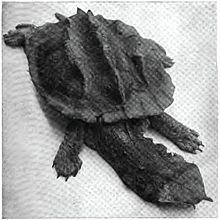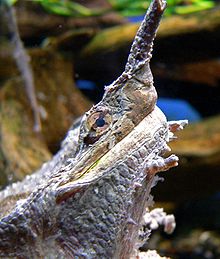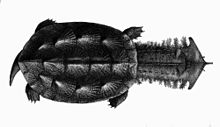Mata mata
| Mata mata Temporal range:
| |
|---|---|

| |
| In Shanghai Aquarium, China | |
| Scientific classification | |
| Domain: | Eukaryota |
| Kingdom: | Animalia |
| Phylum: | Chordata |
| Class: | Reptilia |
| Order: | Testudines |
| Suborder: | Pleurodira |
| Family: | Chelidae |
| Genus: | Chelus |
| Species: | C. fimbriata
|
| Binomial name | |
| Chelus fimbriata | |
| Synonyms[1][6] | |
|
Species synonymy
| |
The mata mata, mata-mata, or matamata (Chelus fimbriata)[7] is a South American species of freshwater turtle found in the Amazon basin and river system of the eastern Guianas. It was formerly believed to also occur in the Orinoco basin, western Guianas and upper Rio Negro–Branco system, but in 2020 these populations were found to belong to a separate species, Chelus orinocensis (Orinoco mata mata).[1][8] Subsequently, some authorities have modified the common name of Chelus fimbriata to Amazon mata mata.[1] These two are the only extant species in the genus Chelus.[1][8]
Taxonomy
[edit]The mata mata first became known to western scientists when it was described by French naturalist Pierre Barrère in 1741 as a "large land turtle with spiky and ridged scales" (translation).[9] It was first scientifically described as Testudo terrestris in 1765 by Spanish zoologist Fermín Zanón Cervera, but the same scientific name was used for describing the Greek tortoise by Peter Forsskål posthumously in 1775. In 1783, the mata mata was scientifically described again, this time as Testudo fimbriata by German naturalist Johann Gottlob Schneider. In 1805, it was moved to its own genus as Chelys fimbriata by André Marie Constant Duméril.[1][10] From the mid 1700s to the late 1800s, altogether 15 different scientific names were used for the species.[11] Since the late 1800s, most authorities have used the name Chelys fimbriata. In 1963, the International Commission on Zoological Nomenclature resolved the issue of Testudo terrestris (Fermín 1765) by declaring it a nomen oblitum (meaning that only Testudo terrestris Forsskål 1775 is valid and a synonym for the Greek tortoise), while also declaring that Chelys fimbriata is a conserved name for the mata mata.[1][10]
In 1995, distinct morphological differences were found between the populations of the Amazon and Orinoco basins.[12] In 2020, this was supported by a genetic analysis, which showed a deep split between two of its populations. The authors proposed that the mostly Orinoco population be assigned to a new species, Chelus orinocensis, with the Amazon population retaining the Chelus fimbriatus. However, Chelus fimbriatus is absent from the upper Rio Negro–Branco system (the northernmost part of the Amazon basin), which instead is inhabited by Chelus orinocensis.[8]
Anatomy and morphology
[edit]
The mata mata is a large, sedentary turtle with a large, triangular, flattened head with many tubercles and flaps of skin, and a "spike" on its long and tubular snout.[9] Three barbels occur on the chin and four additional filamentous barbels at the upper jaw, which is neither hooked nor notched.[13]
The mata mata's brown or black, oblong carapace can measure up to 95 cm (37 in) at adult age.[14] The full adult weight is 21 kg (46 lb).[14] The mata mata's plastron is reduced, narrowed, hingeless, shortened towards the front, and deeply notched at the rear with narrow bridges.[13] These may be meant to allow the turtle to resemble a piece of bark, camouflaging it from possible predators.[15] The plastron and bridges are cream to yellow or brown.[13] The head, neck, tail, and limbs are grayish brown on adults.[13] The neck is longer than the vertebra under its carapace and is fringed with small skin flaps along both sides.[13] Hatchlings show a pink to reddish tinge in the underside edge of their carapaces and plastrons that gradually disappear as they grow.
Each forefoot has five webbed claws. Males have concave plastrons and longer, thicker tails than females.[13]
Habitat
[edit]The mata mata inhabits slow moving streams, stagnant pools, marshes, and swamps ranging into northern Bolivia, eastern Peru, eastern Ecuador, southeastern Colombia, the eastern Guianas, and northern and central Brazil.[1] The mata mata is strictly an aquatic species but it prefers standing in shallow water where its snout can reach the surface to breathe.[16]
Behavior
[edit]

The appearance of the mata mata's shell resembles a piece of bark, and its head resembles fallen leaves.[17] As it remains motionless in the water, its skin flaps enable it to blend into the surrounding vegetation until a fish comes close.[17] The mata mata thrusts out its head and opens its large mouth as wide as possible, creating a low-pressure vacuum that sucks the prey into its mouth, known as suction feeding.[17] The mata mata snaps its mouth shut, the water is slowly expelled, and the fish is swallowed whole; the mata mata cannot chew due to the way its mouth is constructed.[17]
Reproduction
[edit]Males display for females by extending their limbs, lunging their heads toward the females with mouths agape, and moving the lateral flaps on their heads. Nesting occurs from October through December in the Upper Amazon. The 12 to 28 brittle, spherical, 35 mm-diameter eggs are deposited in a clutch.
Diet
[edit]This section needs expansion. You can help by adding to it. (March 2018) |
The mata mata is carnivorous, feeding almost exclusively upon aquatic invertebrates (such as worms, mussels, crustaceans and insects)[18][19][20] and fish.[9][17] On rare occasions, it may feed on small birds, amphibians or small mammals that have entered the water.[21][20] When the stomach content of 20 wild mata mata turtles was examined it consisted exclusively of small fish. The turtles predominantly feed at night in muddy water with limited visibility. However the turtle is well adapted to hunting in these conditions. The mata mata has very fine eyesight with eyes that reflect light, similar to other nocturnal reptiles. In addition, the skin flaps on the neck are also extremely sensitive and help the mata mata detect nearby movement.[22]
Mata mata turtles use a specific method of seizing their prey. They will move the prey into shallower areas of water, surround the prey, and wave their front legs to prevent them from escaping. Once surrounded, the mata mata turtles will open their mouths and contract their pharynx, causing a rush of water that pushes the prey into their mouth.[23]
In captivity
[edit]
Mata mata turtles are readily available in the exotic pet trade and are quite expensive to obtain. Due to their unique appearance, they make interesting display animals. They also grow quite large. However, mata matas are not active hunters, so, like the alligator snapping turtle, they need less space than a large, active species.
As with all aquatic turtles, water quality is one of the keys to keeping this species successfully in captivity. Warm, acidic water is the best type used with a high tannin content that should be maintained all year round. Moderate to heavy filtration is recommended.[24] Author David Fogel considers his captive mata mata turtles to be quite intelligent. For example, he has observed one turtle positioning itself near the spray bar of the aquarium at feeding time so that floating food is pushed beneath the water's surface where the turtle can catch it more easily.[25]
References
[edit]- ^ a b c d e f g h Rhodin, Anders G.J.; Inverson, John B.; Roger, Bour; Fritz, Uwe; Georges, Arthur; Shaffer, H. Bradley; van Dijk, Peter Paul; et al. (Turtle Taxonomy Working Group) (2021). Rhodin A. G.J.; Iverson J.B.; van Dijk P.P.; Saumure R.A.; Buhlmann K.A.; Pritchard P.C.H.; Mittermeier R.A. (eds.). "Turtles of the world, 2021 update: Annotated checklist and atlas of taxonomy, synonymy, distribution, and conservation status (9th Ed.)". Chelonian Research Monographs. Conservation Biology of Freshwater Turtles and Tortoises: A Compilation Project of the IUCN/SSC Tortoise and Freshwater Turtle Specialist Group. 9 (8 ed.): 1–472. doi:10.3854/crm.8.checklist.atlas.v9.2021. ISBN 978-1-5323-5026-9.
- ^ "Appendices | CITES". cites.org. Retrieved 2023-03-01.
- ^ a b Schneider, J.G. 1783. Allgemeine Naturgeschichte der Schildkröten, nebst einem Systematischen Verseichnisse der einzelnen Arten. Müller, Leipzig. xlviii + 364 p.
- ^ ICZN. 1963. Opinion 660. Suppression under the plenary powers of seven specific names of turtles (Reptilia: Testudines). Bulletin of Zoological Nomenclature 20:187-190.
- ^ Duméril, A.M.C. 1806. Zoologie Analytique, ou Méthode Naturelle de Classification des Animaux. Paris: Perronneau, 344 pp.
- ^ Fritz Uwe; Peter Havaš (2007). "Checklist of Chelonians of the World". Vertebrate Zoology. 57 (2): 327. doi:10.3897/vz.57.e30895. ISSN 1864-5755. S2CID 87809001.
- ^ Giant fossil matamata turtles (matamatas part V) Archived 2011-10-11 at the Wayback Machine, Tetrapod Zoology
- ^ a b c Vargas-Ramírez, M.; Caballero, S.; Morales-Betancourt, M.A.; Lasso, C.A.; Amaya, L.; Gregorio Martínez, J.; das Neves Silva Viana, M.; Vogt, R.C.; Pires Farias, I.; Hrbek, T.; Campbell, P.D.; Fritz, U. (2020). "Genomic analyses reveal two species of the matamata (Testudines: Chelidae: Chelus spp.) and clarify their phylogeography". Molecular Phylogenetics and Evolution. 148: 106823. Bibcode:2020MolPE.14806823V. doi:10.1016/j.ympev.2020.106823. PMID 32278863. S2CID 215751367.
- ^ a b c Espenshade III, William H (1990), "Matamata, Chelus fimbriatus", Tortuga Gazette, 26 (5): 3–5
- ^ a b Chelus fimbriata, The Reptile Database
- ^ Matamata, Chelus fimbriatus, California Turtle & Tortoise Club
- ^ Sanchez-Vilaga, Marcelo R.; Prichard, Peter C. H.; Paolillo, Alfredo; Linares, Omar J. (January 1995). "Geographic variation in the matamata turtle, Chelus fimbriatus, with observations on its shell morphology and morphometry" (PDF). Chelonian Conservation and Biology. 1: 292–300.
- ^ a b c d e f Bartlett, Dick (2007), "The Matamata", Reptiles Magazine, 15 (12): 18–20
- ^ a b (in French) Toutes les tortues du monde by Franck Bonin, Bernard Devaux and Alain Dupré, second edition (1998), editions Delachaux and Niestlé/WWF.
- ^ Encyclopedia of Animals: Mammals, Birds, Reptiles and Amphibians, Harold G. Cogger, Edwin Gould, Joseph Forshaw
- ^ Rosenfeld, Arthur (1989), Exotic Pets, New York: Simon & Schuster, pp. 153–155, ISBN 978-0-671-47654-0
- ^ a b c d e Cogger, Harold; Zweifel, Richard (1992), Reptiles & Amphibians, Sydney, Australia: Weldon Owen, p. 112, ISBN 978-0-8317-2786-4
- ^ "Mata Mata Turtle: Care Guide & Species Profile". 22 February 2022.
- ^ "Mata mata turtle, Chelus fimbrata, care sheet". 14 April 2020.
- ^ a b Hailey, A. "Chelus fimbriatus (Mata Mata Turtle)" (PDF). UWI St. Augustine. Retrieved 2023-12-16.
- ^ "Matamata - the Animal Facts - Habitat, Appearance, Diet, Behavior".
- ^ Fogel, David (2011). Matamatas: The Natural History, Captive Care and Breeding of Chelus fimbriatus. Turtle and tortoise preservation Group Turtles of the world series.
- ^ Wise1, Formanowicz Jr.2, Brodie Jr.3, Scott C.1, Daniel R.2, Edmund D.3 (September 1989). "Matamata Turtles Ambush but Do Not Herd Prey". Journal of Herpetology. 23 (3): 297–299. doi:10.2307/1564454. JSTOR 1564454.
{{cite journal}}: CS1 maint: multiple names: authors list (link) CS1 maint: numeric names: authors list (link) - ^ Mata mata Care Sheet
- ^ Fogel, David (2011). Matamatas: The Natural History, Captive Care and Breeding of Chelus fimbriatus. Turtle and Tortoise Preservation group's Turtles of the world series.
- IUCN Red List least concern species
- Chelus
- Turtles of South America
- Fauna of the Amazon
- Reptiles of Bolivia
- Turtles of Brazil
- Reptiles of Colombia
- Reptiles of Ecuador
- Reptiles of French Guiana
- Reptiles of Peru
- Reptiles of Suriname
- Reptiles described in 1783
- Extant Pliocene first appearances
- Taxa named by Johann Gottlob Theaenus Schneider

